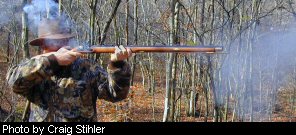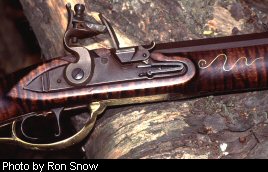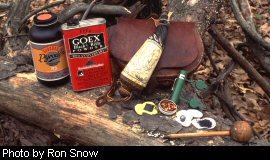

Shooting for Small Game: Lock, Stock and BarrelBy Gary Strawn
In the late 1970s the interest in traditional blackpowder hunting was rekindled. West Virginia had its first muzzleloader hunting season for deer in 1980. Only flintlock firearms with a minimum caliber of .44 were legal. Since that time, regulations have been changed to allow both the use of percussion-cap rifles and in-line muzzleloaders, and the reduction of caliber size to .36. Beginning with the fall of 2002, telescopic sights were permitted for use during muzzleloader deer season. Even though blackpowder hunting for small game has not been as regulated, not many hunters have participated in this type of hunting. Muzzleloader hunters may use their firearms for taking any small game that is in season. First time hunters who pursue small game with a muzzleloading rifle will probably use the same rifle they have used for deer. If not approached with some thought, it can have disappointing results. Needless to say, you will be trying to hit a smaller animal. Here are some suggestions to improve your ability to hit that smaller target. First, you need to know if your rifle is best suited for a patched round ball or a conical bullet. This is determined by the twist of your rifle. Twist refers to the spiral or turn of the rifling (grooves) in a given distance. This is the distance that the projectile travels to make one complete revolution. A rifle with a slow twist has one turn in 66 to 72 inches. A patched round ball is best suited for these rifles. Conical bullets are best suited for rifle barrels with a fast twist which ranges from one turn in 32 to 48 inches of barrel length. Today's market provides rifles in both fast and slow twists and calibers ranging from .36 to .54. A patched round ball in a rifle with a slow twist was once considered to provide better accuracy than a conical bullet in a rifle with a fast twist.
If you are planning to purchase a muzzleloading rifle for small game, consider one of the smaller calibers . A few years ago .32- and .36-caliber rifles were difficult to find and had to be special ordered or made by one of today's gunmakers . Today a few companies are offering them as part of their selection. The most common muzzleloaders available are still .45-, .50- and .54-caliber rifles. While any caliber that is .36 or above is legal for deer and can be used for small game, the more sincere small game hunters may use .32- and .36-caliber rifles. Interest in the muzzleloading shotgun has not increased among hunters as much as interest in the rifle but some hunters have discovered its utility. The 12-gauge muzzleloading shotgun is the most common one found in today's market but 10- and 20-gauges are also available. The muzzleloading shotgun is similar to the muzzle-loading rifle as far as what you need to do to have an enjoyable hunt but the ramrod has to make one more trip down the barrel when loading. After the powder is poured into the barrel, a wad is placed over it, shot poured in, then another wad is placed over the shot to keep it in place. You should pattern your shotgun with different powder charges. You should also pattern at least two different shot sizes if you plan to hunt different species like squirrel and dove. For example, you might want to use 5 or 6 shot for squirrel and 7-1/2 or 8 shot for dove. As with a rifle, practice is important, particularly if you are wingshooting . You will not be able to get the fast shot velocity with blackpowder that is obtainable with smokeless powder. This can affect the “lead” needed for wingshooting . For shotgunners , blackpowder hunting for small game can offer you about six months of enjoyment. The shotgunner can start hunting dove in September; pursue squirrel, grouse and turkey in October; and continue with rabbit hunting in November until the end of February. Some sections of the state also offer limited quail, woodcock and pheasant hunting as a challenge.
If you are considering black-powder hunting for the first time, you need to know a few safety rules in addition to regular gun safety. First, as a traditional blackpowder hunter, you are carrying quantities of gunpowder that can explode. Always be careful with open containers of blackpowder . Keep them away from open flames, heat or sparks. Be extra careful if you are a smoker. When reloading after a shot, never pour powder from the powder horn or can into the muzzle – use a powder measure. Some powder in the barrel may still be burning and could ignite the entire amount which could result in an explosion. Never use smokeless powder in a muzzleloader. Be certain that the ball or bullet is seated on the powder. If not, this can be the same as a restriction in the barrel and cause the barrel to explode. If you have a “misfire” or “ hangfire ,” keep the muzzle pointed in a safe direction for a few minutes, then try firing the gun again. If it still won't fire, you may have to pull the load. If you have never done this before you should seek help from someone who has. With the increased interest in blackpowder hunting, several magazines and books are available that can provide the hunter with a wealth of information. There are also more hunters now than 20 years ago who have some knowledge about blackpowder hunting. They can relate do's and don'ts about muzzle-loaders. For the sportsman who desires more hunting opportunity and wants more of a challenge while hunting, blackpowder hunting for small game can be very rewarding. Gary Strawn is a district wildlife biologist stationed in Romney . |
 “Lock, stock and barrel.” “Just a flash in the pan.” “Keep your powder dry.” These are sayings that, even though used with different meaning today, originally referred to muzzleloaders. The muzzleloader was the firearm used until after the Civil War when the breech-loading firearm and powder contained in a cartridge came into use. A few hunters who enjoyed the challenge of that type of firearm continued to use muzzleloaders. Today, muzzleloader hunting is one of the fastest growing shooting sports.
“Lock, stock and barrel.” “Just a flash in the pan.” “Keep your powder dry.” These are sayings that, even though used with different meaning today, originally referred to muzzleloaders. The muzzleloader was the firearm used until after the Civil War when the breech-loading firearm and powder contained in a cartridge came into use. A few hunters who enjoyed the challenge of that type of firearm continued to use muzzleloaders. Today, muzzleloader hunting is one of the fastest growing shooting sports.  Here are some suggestions to improve your accuracy with either type of bullets. Experiment with various powder loads to determine which gives the best shot group. Use a good set of sights with which you are comfortable. And finally – practice! Don't expect to pick up your rifle and be an expert without any practice. It is also a good idea to limit the distance that you shoot to less than 30 yards.
Here are some suggestions to improve your accuracy with either type of bullets. Experiment with various powder loads to determine which gives the best shot group. Use a good set of sights with which you are comfortable. And finally – practice! Don't expect to pick up your rifle and be an expert without any practice. It is also a good idea to limit the distance that you shoot to less than 30 yards.  The rifle hunter can take squirrel from early October until the end of January. I also know of a few blackpowder shooters who hunt woodchucks in the summer. Their challenge is not in making a 200- or 300-yard shot, but the 50- or 100-yard shot with open sights, as well as in stalking the animal.
The rifle hunter can take squirrel from early October until the end of January. I also know of a few blackpowder shooters who hunt woodchucks in the summer. Their challenge is not in making a 200- or 300-yard shot, but the 50- or 100-yard shot with open sights, as well as in stalking the animal.